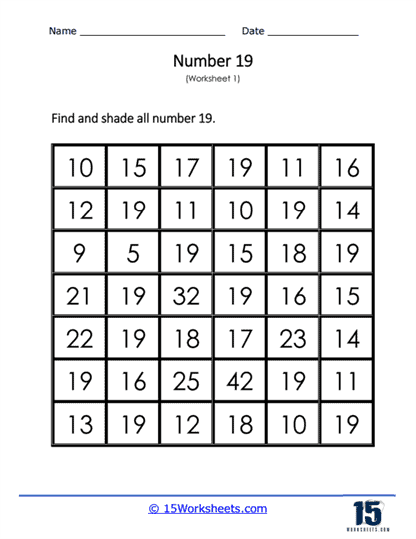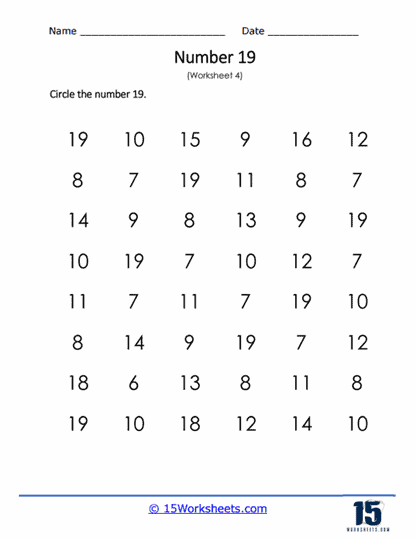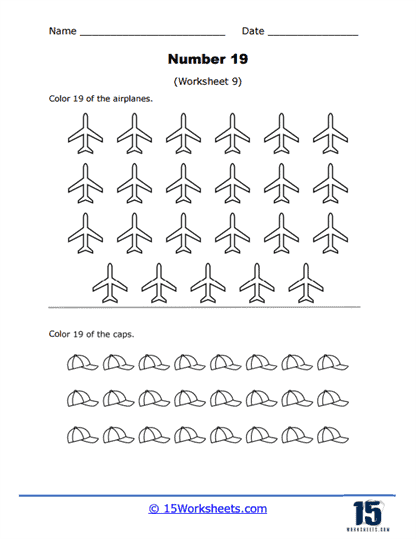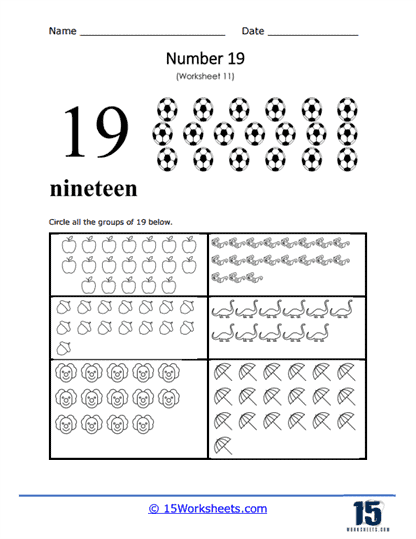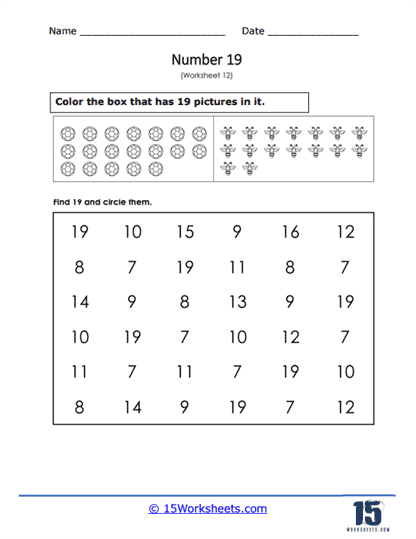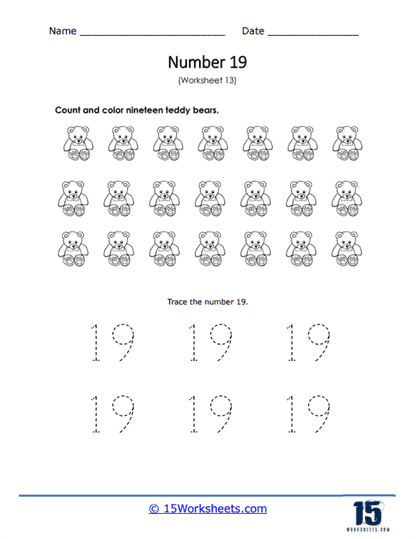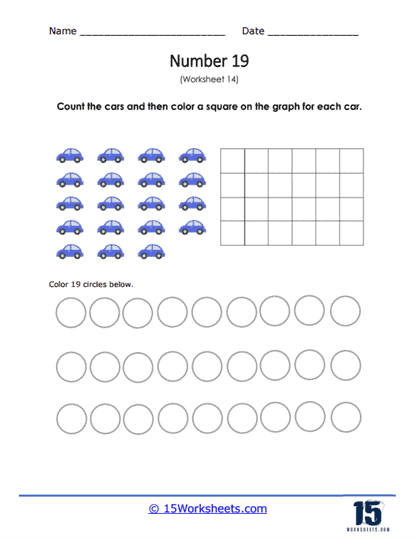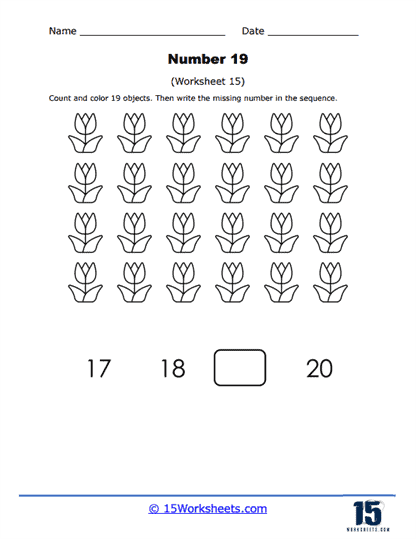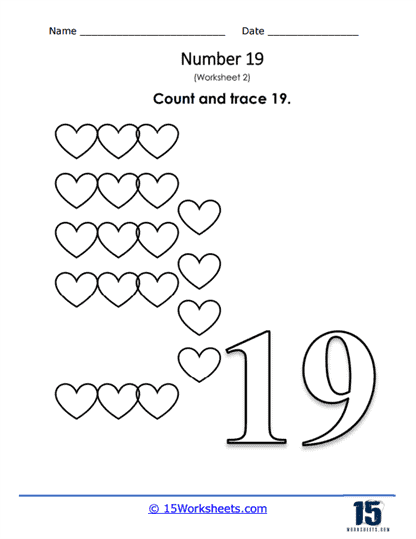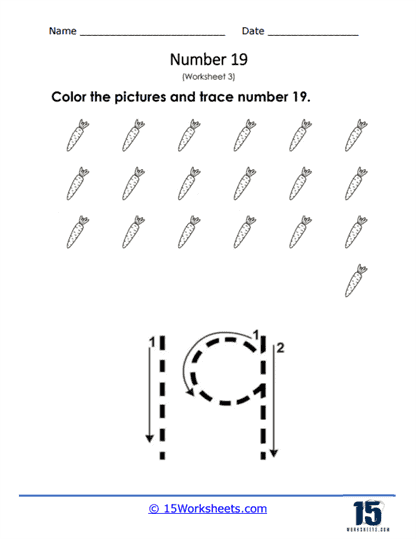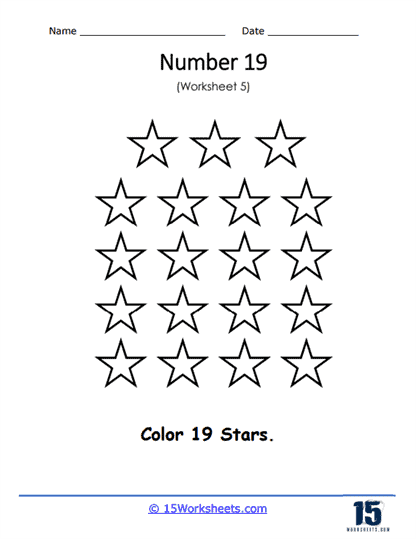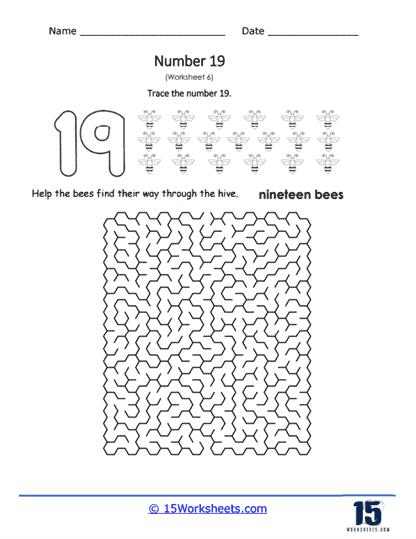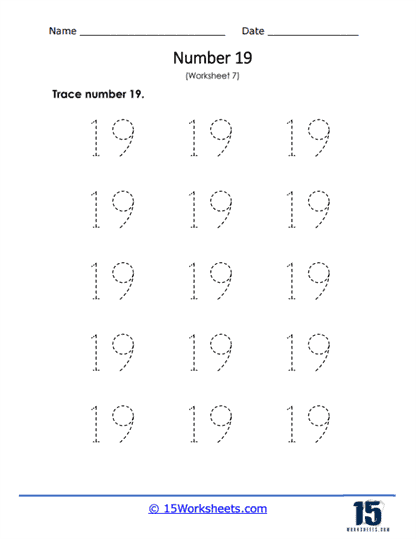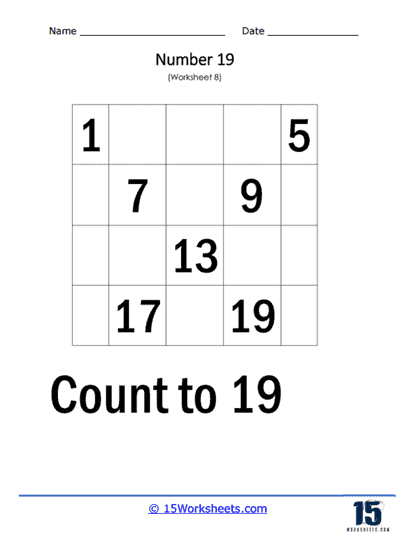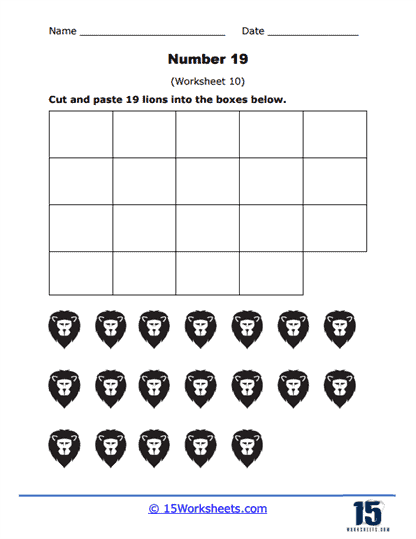Number 19 Worksheets
About These 15 Worksheets
Learning numbers can be an exciting adventure, especially when the process is made enjoyable and engaging. Worksheets that focus on specific numbers, such as the number 19, are designed to turn what could feel like a complex or repetitive task into an interactive experience that helps students like you understand math in a fun and memorable way. By breaking down concepts into manageable pieces and using visual aids, these worksheets offer a hands-on approach to learning that enhances both understanding and retention.
One of the biggest benefits of these worksheets is that they help you build a strong foundation in numbers and math. This foundation is critical for your ongoing success in more advanced math topics. Think of learning about numbers like constructing a building—without a solid foundation, the structure will not stand firm. The number 19 may seem like just another step in your learning journey, but mastering it through engaging activities can provide the confidence you need to tackle more complex mathematical concepts in the future.
The variety of exercises within this series of worksheets allows you to engage with the number 19 in multiple ways. By counting, writing, visualizing, and recognizing the number in various forms, you’ll start to see how the number 19 fits into a broader understanding of mathematics. For instance, activities that involve counting and writing the number help reinforce not just the appearance of the number, but also its place within the number system. When you practice visualizing and recognizing 19, you develop a more intuitive sense of how numbers function and how they relate to each other.
Pattern recognition and sequences are other essential parts of understanding numbers. Worksheets that guide you in exploring patterns with the number 19 encourage you to look beyond memorization. These exercises prompt you to think critically about how numbers are structured and how they grow, helping you to grasp more abstract mathematical concepts. Patterns help you discover the consistency and logic behind numbers, revealing the fascinating rules that govern math.
But here’s the best part: while you’re learning, you’re also having fun. The interactive nature of these worksheets is designed to make the learning process enjoyable rather than something to dread. Each exercise is a small challenge, like a puzzle waiting to be solved, which can transform what might feel like hard work into a game of discovery. This approach helps you stay motivated and eager to learn, turning each worksheet into an opportunity to strengthen your skills.
As you work through these exercises, remember that practice truly does make perfect. Repetition through enjoyable activities builds muscle memory for your brain, ensuring that what you learn sticks with you. Every time you practice counting to 19, or identifying it among other numbers, you are reinforcing your ability to recognize it instantly. This skill is foundational because, as you progress in math, quick and accurate recognition of numbers will help you solve more complex problems faster.
Here are the types of activities that you can expect to see on these worksheets:
Counting – One of the fun exercises you’ll find on these worksheets is counting. You’ll see groups of objects, like toys or animals, and you’ll be asked to count how many there are. By counting and recognizing that there are 19 objects in the group, you’ll become more familiar with the number 19 and its quantity.
Writing – Another exciting activity you’ll find on these worksheets is writing the number 19. You’ll get to trace and practice writing the number 19 several times. This exercise helps you remember how to write the number correctly and neatly.
Visualizing – Worksheets include pictures of objects or animals, and you’ll be asked to circle or color the ones that represent the number 19. This activity helps you visualize what 19 looks like and identify it in different contexts.
Number Recognition – There might be exercises where you’ll need to find the number 19 among a group of other numbers. By searching for and recognizing the number 19, you’ll become more familiar with its shape and identify it more easily.
Patterns and Sequences – Some worksheets will challenge you to find patterns and sequences involving the number 19. For example, you might need to fill in missing numbers in a sequence like 10, 11, 12, __, 14, 15, 16, 17, 18, __, 20. By figuring out the missing numbers, you’ll learn more about how numbers fit together and continue in a sequence.
Why is the Number 19 Special?
The number 19 holds a unique place in history, culture, religion, and mathematics, making it a subject of fascination across various fields. From ancient civilizations to modern times, this number has been associated with mystical, symbolic, and scientific significance, standing out in both religious texts and numerical theory. To explore why the number 19 is special, we can begin by looking at its presence in numerology and religion, its mathematical properties, and its influence on culture.
Religious and Mystical Significance
In many religious traditions, the number 19 is considered sacred or significant. In Islam, for instance, the number 19 is central to the structure of the Quran. A concept called “The Quranic Code” was discovered by Egyptian biochemist Dr. Rashad Khalifa, who found that the entire text of the Quran is intricately structured around the number 19. For example, the Quran has 114 surahs, which is 19 times 6, and the first verse consists of 19 Arabic letters. This numerical phenomenon is viewed by some as evidence of divine precision. The number 19 is also referenced directly in the Quran (Chapter 74:30), adding to its spiritual weight.
The Bahá’í Faith, another religious tradition, elevates the number 19 to an organizational principle. The Bahá’í calendar consists of 19 months, each with 19 days, and it has deep symbolic meaning representing unity, harmony, and the connection between humanity and the divine. This recurrence of 19 in different religious contexts suggests its importance in spiritual systems throughout history.
Mathematical Properties
Mathematically, 19 is a prime number, which means it can only be divided by 1 and itself, a trait that lends it a kind of indivisibility and purity. Prime numbers have long been associated with mystical properties because they represent building blocks in the number system. The uniqueness of 19 as a prime number also appears in some interesting mathematical puzzles and properties. For example, 19 is part of a twin prime pair (17 and 19) and a centered hexagonal number, adding to its geometrical appeal.
19 is also a “happy number,” which means that if you repeatedly sum the squares of its digits, the process eventually leads to the number 1, creating a satisfying cyclical pattern. These distinct mathematical traits help explain why 19 has intrigued mathematicians for centuries, often inspiring further exploration of its properties and relationships to other numbers.
Cultural and Historical Importance
Throughout history, 19 has had a particular resonance in certain cultures. For instance, in ancient Babylonian astronomy, the number 19 was connected to the Metonic cycle, a period of 19 years that synchronized the lunar and solar calendars. This cycle was used by early astronomers to predict eclipses and track time, highlighting the number’s connection to cosmic patterns.
In modern times, the number 19 took on historical importance with events like the signing of the U.S. Constitution in 1787, which resulted in the creation of the 19th Amendment in 1920. This amendment granted women the right to vote in the United States, marking a significant moment in the country’s history and embedding the number 19 in the collective consciousness as a symbol of progress and equality.
In literature and popular culture, the number 19 has appeared as a symbol of change or transformation. Stephen King’s The Dark Tower series, for example, frequently references the number 19, linking it to events, characters, and plot twists that drive the narrative’s deeper meanings. The number is associated with fate, destiny, and hidden connections, reinforcing its mystical and symbolic importance.
Science and Nature
The number 19 also appears in the natural world and scientific studies. For example, the atomic number of potassium is 19, an element crucial for human health and cell function. In biology, the human body produces antibodies with chains of 19 amino acids. Even in astronomy, 19 years is significant because of the Metonic cycle, which weaves together the rhythms of the sun and moon.
The number 19 is often encountered in geometric and spatial arrangements, such as in group theory, where symmetries and dimensions can relate to this prime number. In chemistry, potassium’s atomic number is 19, another example of how it plays a role in the foundational elements of the natural world. Thus, 19 is woven into the fabric of scientific and biological structures that define life and the universe.

